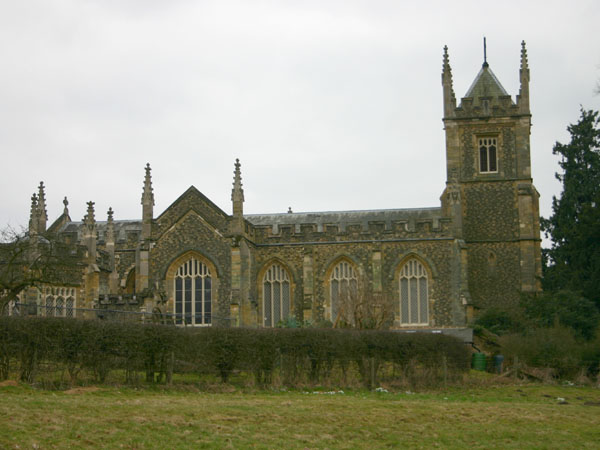Catholic Apostolic Church

Another contribution to this series, started by sadexploration, is the Catholic Apostolic church, Albury.
Henry Drummond was a man of ability and distinction. He was a Member of Parliament and a leading figure in the City of London, he was also the patron of the parish of Albury and, as such, possessed the right to nominate its Rector for appointment by the Bishop. Drummond's interest in the church, however, extended far beyond the power and influence that it conferred on him. He was a man who had a developed spiritual awareness.
Within five years of his buying the mansion in Albury Park in 1819 Drummond had gathered about him a group of associates to examine and discuss the teachings of the charismatic Scottish preacher, Edward Irving. Irving's interpretation of the Book of Revelation, which excited wide interest at the time, was later to evolve into the doctrines which were to distinguish him from his Presbyterian origins and, eventually, to his establishing a distinct church.
Drummond's group met regularly, and from 1826, it conducted series of annual conferences at Albury Park to examine the manifestations and teachings of Irving's ideology. The Rector of Albury, the Reverend Hugh McNeile and a number of other Church of England clergy joined in these events. But as Irving's teaching took a stronger hold over Drummond's associates, and particularly after 1832 when his followers established their own Catholic Apostolic Church in the Newman Street Church in London, the Reverend McNeile became anxious to disassociate himself from them. Relations between McNeile and Drummond worsened and the two men were set on divergent courses. Drummond withdrew from the Parish Church in that year and it is said that he did not attend services in it again. McNeile began to preach against the Irvingite movement, but by 1836 the new Catholic Apostolic Church had sufficiently grown in strength and confidence to be able to assert itself by delivering to the Church of England and to King William IV a statement of its distinct, but catholic, position.
The leaders of the new Apostolic Church continued to meet in the mansion only a short distance from the Parish Church that had represented the established Church of the country in Albury for hundreds of years, and Drummond and McNeile remained neighbours.
Drummond's idea for the parish was that it would have a new Parish Church a mile away from the Park in the resited Albury village, and a separate Catholic Apostolic church would be built across the Tillingbourne, in sight of his mansion. The Old Saxon Church would be closed, but would be repaired and its thirteenth century south transept would be transformed into a mortuary chapel for the Drummond family.
In 1839 Drummond began to build the Catholic Apostolic Church. For both new churches Drummond appointed as architect William Macintosh Brookes. Brookes was working in London on St Ann and St Agnes' Church, Gresham Street when he was invited to undertake the building of the two Albury Churches. Drummond, characteristically, had decided views about the style of his two new churches, and Brookes was a competent interpreter of them.
The Catholic Apostolic Church was to be in the 15th century Gothic style, and Brookes' design for it was an early example of the Gothic revival that was to play such a significant part in English church architecture later in the century. He completed the Catholic Apostolic Church in 1840. It is a remarkable example of the Gothic style set in idyllic surroundings, and it immediately achieved Drummond's aim of establishing for the young Apostolic Church a distinctive and distinguished focus.
Unfortunately the church is not open to the public.
The cache has a log book only but no pen so please bring one with you.
If anybody would like to expand this series please do, we would just ask that you could let sadexploration know first so he can keep track of the Church numbers and names to avoid duplication